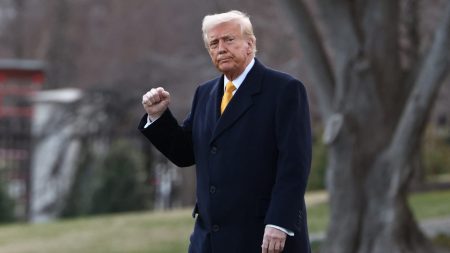President Trump Considers Expanding U.S. Tariffs to Autos, Pharmaceuticals, and Semiconductors
A New Wave of Trade Policy: What You Need to Know
In a recent address at Mar-a-Lago in Palm Beach, Florida, U.S. President Donald Trump hinted at a significant expansion of tariffs on imported goods, targeting automobiles, pharmaceuticals, and semiconductors. This move, if implemented, would mark a bold escalation in the administration’s aggressive trade policy, which has already imposed 25% tariffs on steel and aluminum imports set to take effect in March. The proposed tariffs could be as high as 25% initially, with the potential to increase "very substantially" over the course of a year. While the President did not specify whether these tariffs would apply universally to all imported vehicles or be targeted at specific countries, he suggested they could go into effect as early as April 2.
The Auto Industry: A Key Target in the Crosshairs
The automotive sector is one of the primary focuses of the proposed tariffs. The U.S. imports a significant portion of its vehicles from countries like Mexico, Japan, and Canada. If the tariffs are implemented, these nations could face substantial economic repercussions. However, Trump framed the tariffs as a motivational tool to encourage foreign companies to relocate their manufacturing operations to the U.S. "When they come back into the United States and they have their plant or factory here, there is no tariff," he explained. The President also claimed that some of the world’s largest companies have already expressed interest in returning to the U.S., driven by the administration’s economic policies and incentives.
While the tariffs may create short-term challenges for importers, Trump believes they will ultimately benefit the U.S. economy by fostering domestic production and job creation. However, the impact on American consumers remains uncertain. Higher tariffs on imported vehicles could lead to increased car prices, potentially making new vehicles less affordable for many buyers.
Pharmaceuticals: A Global Supply Chain at Risk
The pharmaceutical industry is another sector that could be heavily affected by the tariffs. Countries like Japan and India, which are major exporters of pharmaceuticals to the U.S., could face significant disruptions. Analysts warn that the tariffs could drive up drug prices for American patients, exacerbate existing supply shortages, and force manufacturers to seek alternative markets.
Ophelia Chan, a senior business fundamentals analyst at GlobalData, highlighted the potential consequences of the tariffs: "The tariffs could drive up drug prices for U.S. patients, exacerbate drug supply shortages, and push manufacturers to seek alternative markets." She also noted that pharmaceutical companies might consider relocating their manufacturing operations to the U.S. or other tariff-free regions to mitigate the impact of the tariffs. However, the full effects of such a shift are still uncertain and could take years to materialize.
Semiconductors: A High-Stakes Industry in the Spotlight
The semiconductor industry is also in the crosshairs of the proposed tariffs. While Trump did not provide a specific timeline for the implementation of these tariffs, they could have significant implications for key players like Taiwan Semiconductor (TSMC), which supplies chips to major U.S. companies such as Nvidia and Apple. The semiconductor industry is highly globalized, with intricate supply chains that span multiple countries. Disrupting this delicate ecosystem could lead to increased costs, delays in production, and potential shortages of essential components.
The tariffs could also have far-reaching consequences for the broader tech industry, as semiconductors are a critical component in everything from smartphones and laptops to advanced military equipment. While the administration may aim to incentivize domestic production of semiconductors, the short-term impact on the industry and consumers could be significant.
The Bigger Picture: A Shift in Global Trade Dynamics
President Trump’s announcement reflects a broader shift in U.S. trade policy, which has become increasingly assertive under his administration. The tariffs on steel and aluminum, set to take effect in March, are already signaling a more protectionist approach to trade. By expanding the scope of tariffs to include automobiles, pharmaceuticals, and semiconductors, the administration is doubling down on its strategy to use tariffs as a tool to influence global trade dynamics and encourage domestic production.
Critics argue that such an approach could lead to retaliatory measures from other countries, potentially sparking a trade war. They also caution that the tariffs could have unintended consequences, such as higher prices for consumers, supply chain disruptions, and long-term damage to international trade relationships. On the other hand, proponents of the policy believe that it will lead to increased domestic production, job creation, and a stronger U.S. economy in the long run.
Expert Insights: Weighing the Risks and Benefits
Analysts like Ophelia Chan underscore the complexity of the issue, noting that while the tariffs may achieve some of the administration’s goals, they could also have significant downsides. "The full effects are still uncertain," she warned, emphasizing that companies may need to adapt quickly to navigate the new trade landscape. This could involve relocating manufacturing operations, diversifying supply chains, or seeking out new markets.
For consumers, the immediate impact of the tariffs could be higher prices for goods ranging from automobiles to life-saving medications. While the administration hopes that domestic manufacturing will eventually offset these costs, the transition period could be fraught with challenges. As the U.S. continues to navigate this contentious trade environment, one thing is clear: the consequences of these policies will be far-reaching, shaping the global economy for years to come.
In conclusion, President Trump’s proposed expansion of tariffs on automobiles, pharmaceuticals, and semiconductors represents a significant escalation in the administration’s trade policy. While the goals of encouraging domestic production and creating jobs are clear, the potential risks to consumers, industries, and global trade relationships are substantial. As the world waits to see how these policies will unfold, one thing is certain: the road ahead will be filled with both opportunities and challenges.









